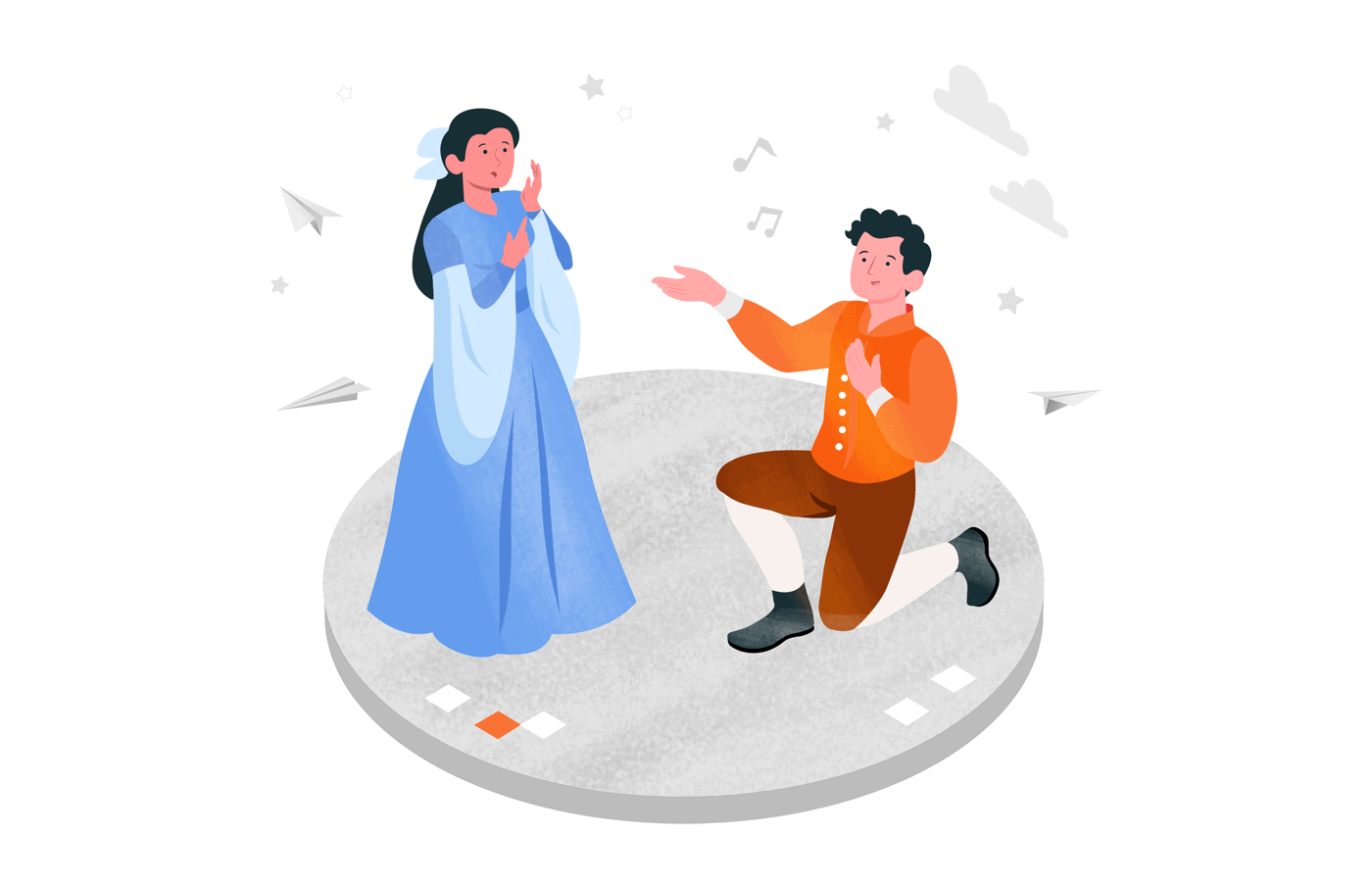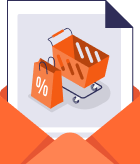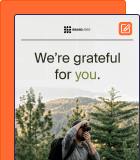Losing customers is disheartening, but don’t lose hope yet. In fact, it’s the best time to double down on your email marketing efforts through targeted win-back campaigns.
Such campaigns nudge past customers and reignite their interest in what you have to offer. At Sender, we’ve tested countless win-back strategies to understand what truly works.
Today, we’re sharing the secrets and best win-back email examples that reduce customer churn and have brought customers back. Let’s start.
What is a Win-back Email?
A win-back email campaign is a way to re-engage inactive customers. These emails tap into human psychology—using FOMO, incentives, or personalized recommendations to make them curious and bring them back.
Think of such emails as a friendly nudge. A well-timed email—whether it’s a “We Miss You” message, a special offer, or a helpful reminder, is sometimes all it takes to get their attention.
Here’s why such marketing emails should be part of your strategy:
- Cheaper than acquiring new customers. Keeping a customer costs 5x less than getting a new one;
- Great engagement booster. Not all inactive customers are lost. Some just need a reason to return;
- They drive real results. Win-back campaigns increase sales. The probability of selling to an existing customer is 60-70% against 5-20% for a new customer.
When to Send Win-Back Emails?
Whenever we’re planning for win-back campaigns, we always remind ourselves that timing is everything. Send come back emails too soon, and it might feel pushy. Too late, and they’ve probably moved on.
The trick is to time it based on behavior—when customers are most likely to notice (and care about) your message.
Here’s when to reach out with a win-back flow for the best chance of revival:
- After a period of inactivity. If a customer hasn’t opened an email, visited your site, or made a purchase in 30, 60, or 90 days, they may need a reminder. Send an email with a subject line like, ‘It’s been a while, [Name]—let’s catch up! Here’s 15% off just for you’;
- Post-purchase lull. Some customers buy once and forget about you. An email like ‘Loved your last order? Here’s a special offer on your next one!’ can turn one-time buyers into repeat customers;
- Abandoned cart or browse activity. If they were interested, but something stopped them from buying, send a gentle nudge. An email with a subject line like ‘Your cart is waiting’ with a special offer can push them to complete the purchase;
- During seasonal or holiday promotions. A holiday or special event can be the perfect excuse to re-engage lapsed customers. Plan a campaign that sends a special discount or gift their way, nudging them to come back and save;
- After a negative experience. A bad review or poor experience is the best time to reach out. It’s an opportunity to repair a relationship. Send an email like, ‘We’re sorry we missed the mark. Here’s how we’re making it right’.
Remember, it’s all about the right moment and hitting their inbox when they’re most likely to care. Now let’s look at some examples to give you ample ideas of such moments throughout the customer journey.
14 Win-Back Email Examples
Now that you know the basics, let’s look at some effective customer win-back emails and real-life win-back email flow examples to inspire successful campaigns that reconnect with inactive subscribers.
1. ‘We Miss You’ Email
Miss you emails remind customers and inactive subscribers about your brand, asking them to engage. An effective re-engagement email uses personalization, humor, and a compelling call-to-action to bring back lost interest.
Belgian Boys sends a warm and cheeky message to remind loyal customers about themselves:
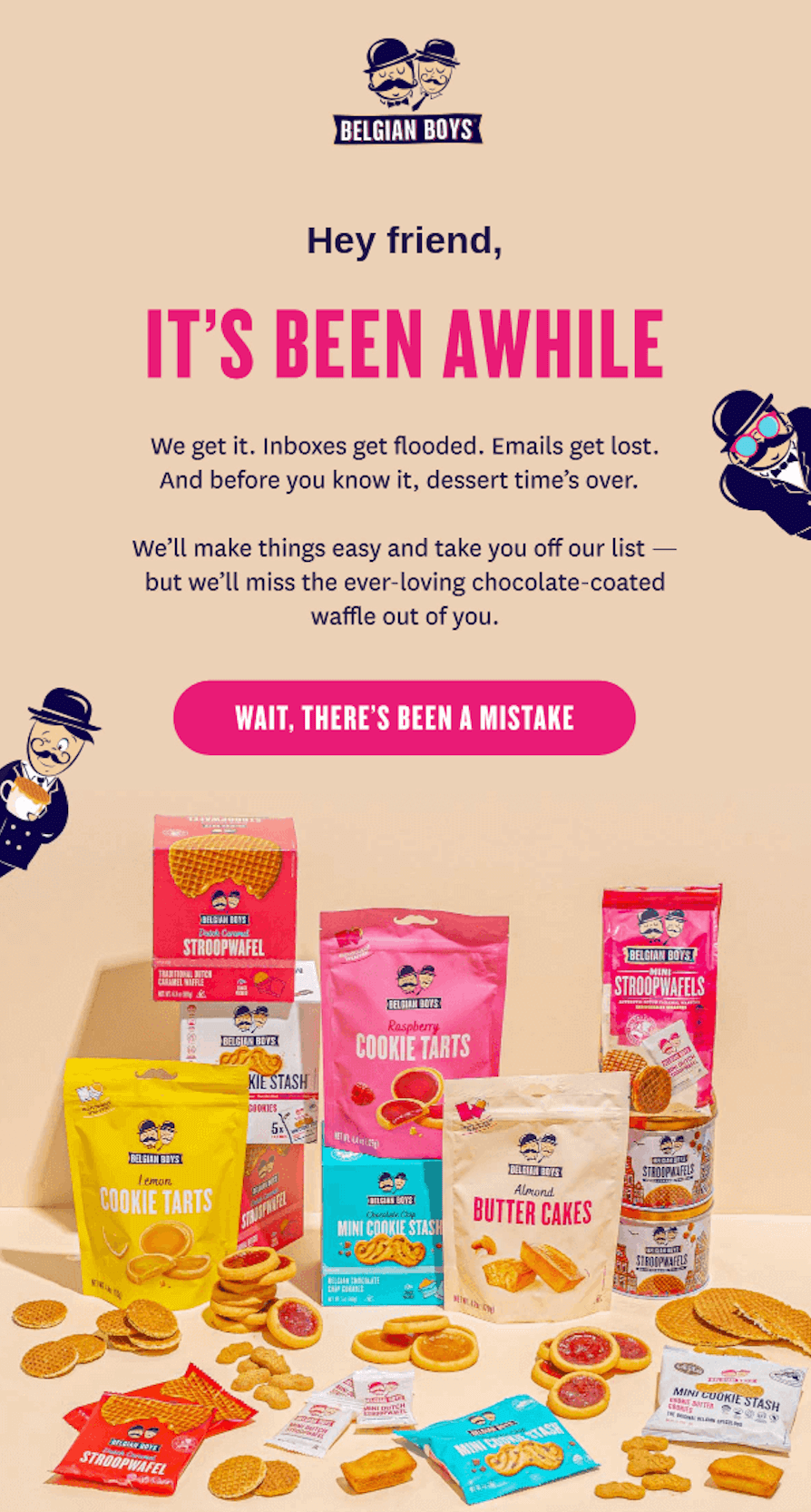
The email body is lighthearted and tastefully uses humor by saying they’ll “miss the chocolate-coated waffle” out of the reader. This makes the brand feel human.
The bold CTA button—”Wait, There’s Been a Mistake”—adds intrigue and reverses the typical unsubscribe dynamic, making users think twice before leaving. The layout is clean, with a focus on customer loyalty rather than bombarding offers.
This example showcases key win-back email design tips: keep the visual hierarchy simple and make your CTA button the hero element that catches the eye immediately.
Email Subject Line
Your subject line is the first thing people read. No pressure, but that decides whether your email gets opened or left to gather virtual dust with the rest of the unopened junk.
If you want the ‘we miss you’ email to reach its destination, you’ve gotta spark curiosity, create a little urgency, or tap into that little thing we call emotion. Throw in some personalization, like the recipient’s name or a custom offer, and sprinkle it with some power words or numbers to make it stand out.
Here are a few Email Subject Line examples to get you going:
- “Long Time No See! Here’s a 20% Off Coupon!”;
- “We Missed You! Come Back and Enjoy a Special Treat”;
- “Haven’t Seen You Lately—Did We Do Something Wrong?”.
Email CTA
You want your call-to-action buttons to be pretty much unmissable, just like in the Belgian Boys’ email. Drop it in the center and make it eye-catching so recipients see it as soon as they open the email.
Use punchy language that makes the action clear. You can never go wrong with CTAs like “Try it out,” “Grab yours,” or “Let’s go”. And if it fits your brand’s voice, don’t be afraid to add a bit of playful banter.
Performance Metrics & Results
Sending a well-crafted ‘we miss you’ email is just the start. You need to track the results to see what’s working and what needs some fine-tuning.
Here are some key metrics you should keep an eye on:
- Open and click rates;
- Conversions;
- Drop-off points.
2. Abandoned Cart Follow-Up
Abandoned cart follow-up emails remind visitors of the products they left behind and nudge them towards finishing their purchase.
Good abandoned cart emails, like the one below by Blueland, balance urgency, reassurance, and a compelling reason to return.
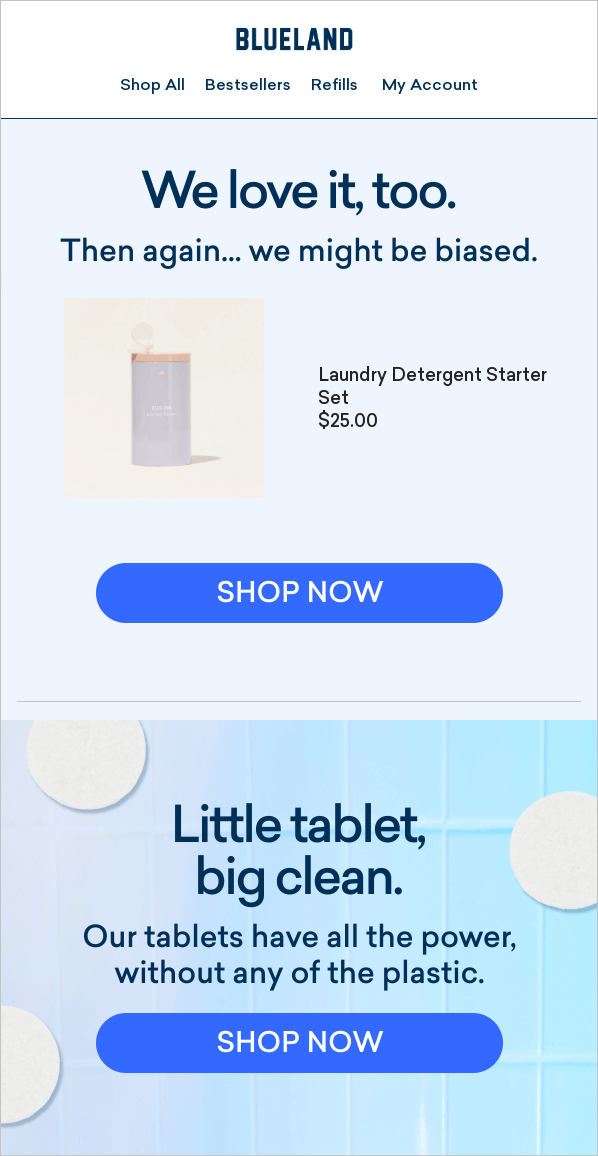
Blueland took a conversational approach with this email. Instead of a generic “You left something behind,” they open with “We love it, too. Then again… we might be biased.”
This makes the email feel personal rather than pushy. The product is displayed with a clean, minimalist aesthetic, reminding the reader about their cart. The bold “Shop Now” CTA button is hard to miss, offering a frictionless way to return to checkout. They could’ve added an incentive like free shipping or an extra discount, though.
Email Subject Line
Think of your subject line as a gentle tap on the shoulder when someone’s walking away from the checkout counter with their hands full. The trick with abandoned cart subject lines is walking that fine line between serving a helpful reminder and being an annoying pest.
You want to create just enough curiosity or urgency to get them back, with some FOMO thrown in for good measure. Personalization also works wonders here—mention their name or reference the specific item they almost bought.
Here are some subject line examples that draw people back:
- “Your Cart is Lonely (and So Are We) 😢”;
- “Forgot Something? Your [Product Name] is Still Here!”;
- “[First Name], Your Cart Expires in 24 Hours!”.
Email CTA
Your CTA should practically be the first thing that meets the recipient’s eyes. Place it after your main message but before they lose interest.
Think snappy calls to action like “Complete My Order” or “Finish Shopping”, rather than generic “Click Here To Finish Your Order.” Keep it action-focused and specific to cart completion.
Performance Metrics & Results
Tracking abandoned cart emails is like checking the pulse of your party—essential for knowing if things are dying down or going great. The metrics tell you whether your gentle nudge brought people back in or if you’re just shouting into the void.
Here’s what metrics matter most:
- Recovery rate and revenue recovered;
- Time between abandonment and conversion;
- Multiple email sequence performance.
3. ‘What You’re Missing’ Email
These emails are designed to create FOMO (fear of missing out) and encourage users to take quick action.
Brands use such emails to promote ongoing offers, loyalty programs, or a final call. Here’s a great email that uses a GIF to make readers curious.
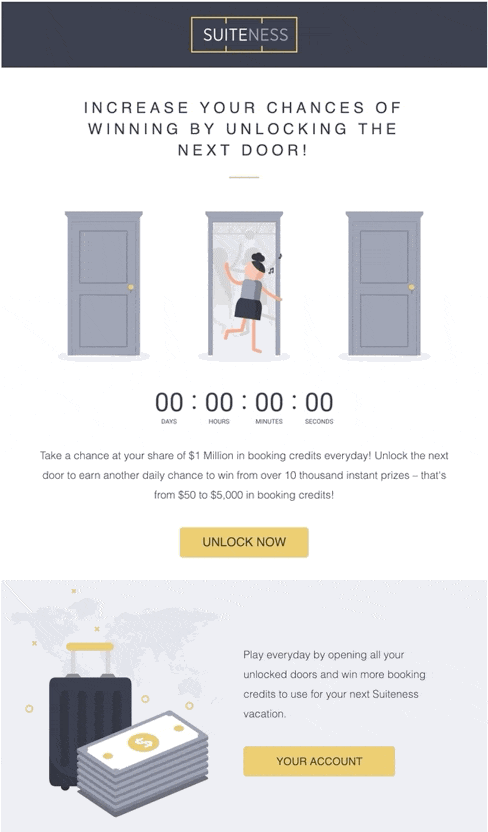
The animated GIF showing a person unlocking a door visually reinforces the concept of missing out on prizes. The countdown timer intensifies the urgency, making it clear that every second counts. The email doesn’t just say, “You’re missing out”—it shows it through dynamic motion and compelling copy.
Mention of a pool of $1 million in booking credits adds a high perceived value, making participation feel worthwhile. The “Unlock Now” CTA in gold stands out, making it easy for recipients to act instantly.
Email Subject Line
These FOMO-driven subject lines are like that friend who always knows about the coolest parties you’re not invited to. It’s all about urgency mixed with exclusivity—making subscribers feel like they’re on the outside looking in at something exciting.
Here are some subject lines that create healthy FOMO:
- “You’re Missing Out on Exclusive Deal, [Name]”;
- “Last 24 Hours: Your Exclusive Access Expires Tomorrow”;
- “While You Were Away, Others Grabbed These Deals”.
Email CTA
When it comes to wording of your CTAs, think action-oriented phrases like “Unlock Now” or “Don’t Miss Out”. Not only do they emphasize urgency, they also reinforce a sense of exclusivity that taps into our psychology.
Performance Metrics & Results
‘What You’re Missing Out’ emails are trickier to measure because you’re essentially weaponizing psychology by inducing fear of missing out. You want to see if that fear translates into action, or if you’re just stressing subscribers out for nothing.
Keep tabs on these key indicators:
- Urgency-driven conversion rates;
- Time-sensitive click patterns;
- Unsubscribe rates vs. engagement spikes.
4. Feedback Request Email
A feedback request email is designed to ask visitors about their opinions (and understand the reason for their inactivity). Usually, such emails have a direct tone with a clear incentive for everyone who chooses to offer their feedback.
But some brands love to add a twist to maximize participation. Have a look at the following email by Grind that turned a simple survey into a sweepstakes.
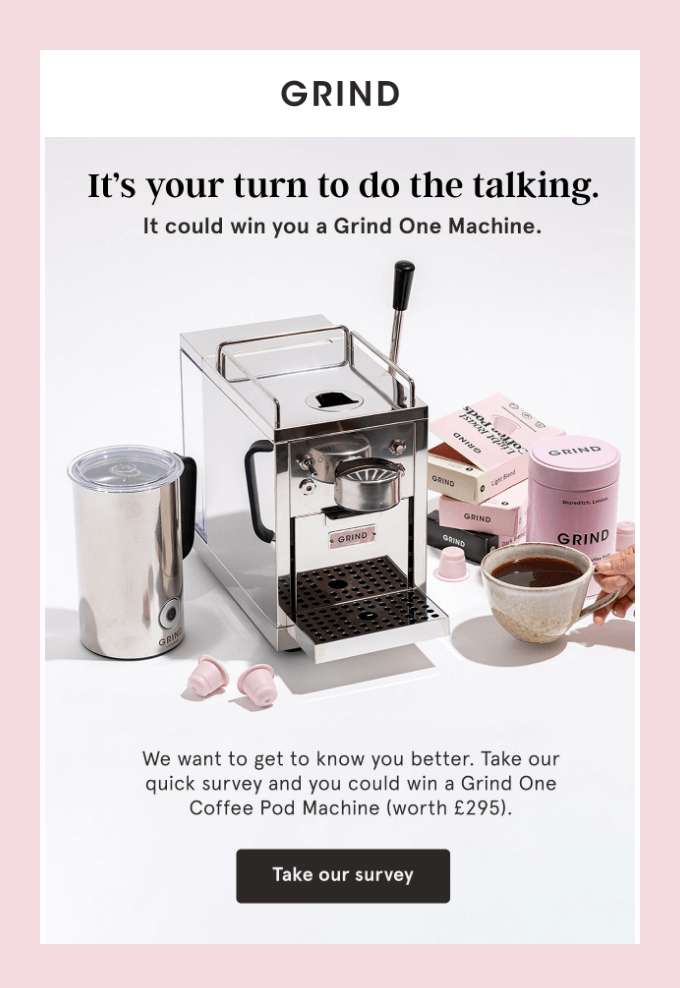
Isn’t this email exciting? The headline — ‘It’s your turn to do the talking’, immediately shifts the focus onto the recipient. The added hook—”It could win you a Grind One Machine”—creates a clear incentive, making participation in the feedback survey more enticing.
The sleek, product-focused imagery reinforces the value of the reward, while the bold, simple CTA button (“Take our survey”) ensures there’s no confusion about what to do next.
This incentive email approach works because it balances a clear request with a compelling encouragement, ensuring recipients feel motivated rather than obligated to respond.
Email Subject Line
Think of feedback request subject lines as asking your neighbor for a favor—you want to be friendly but not desperate. And that’s a hard line to balance.
Mix genuine curiosity with a hint of what’s in it for them. Even if you’re not throwing in a free sample or a discount coupon, a catchy subject line should at least hint there’s something valuable and worth their click waiting inside.
Here are some subject lines that should start you off:
- “Quick Question: How Did We Do, [Name]?”;
- “2 Minutes = Free Coffee (Your Thoughts Please!)”;
- “We Messed Up Somewhere—Help Us Fix It?”.
Email CTA
Now that you’ve got one foot in the door, your feedback CTA needs to feel less like homework and more like having a chat. The best feedback email CTAs acknowledge that you’re asking for their time and make it worth their while.
Go with something like “Share Your Thoughts,” “Tell Us How We Did,” or “Quick Survey (2 mins tops!)”. And position it where subscribers couldn’t miss it, but don’t make it seem like you’re desperate.
Performance Metrics & Results
Measuring feedback emails is trickier than your typical marketing campaigns. This is because you’re essentially asking people to do you a favor.
What you’re looking for here are quality responses, not just quantity, because one solid piece of feedback beats ten rushed clicks through your survey.
Here are the key metrics you should keep an eye on:
- Response completion rates;
- Quality of feedback vs. incentive cost;
- Post-survey engagement patterns.
5. Offer an Irresistible Deal
Discount codes and incentives are the best ways to win back lost customers. Offering an incentive can be a great motivator for customers thinking about buying from you again.
This incentive needn’t necessarily be a discount code. You can offer them other incentives, such as bonus gifts, extra reward points, free shipping, free consultation, and more.
For example, Google sent out an email announcing a free custom email address to users for three months.
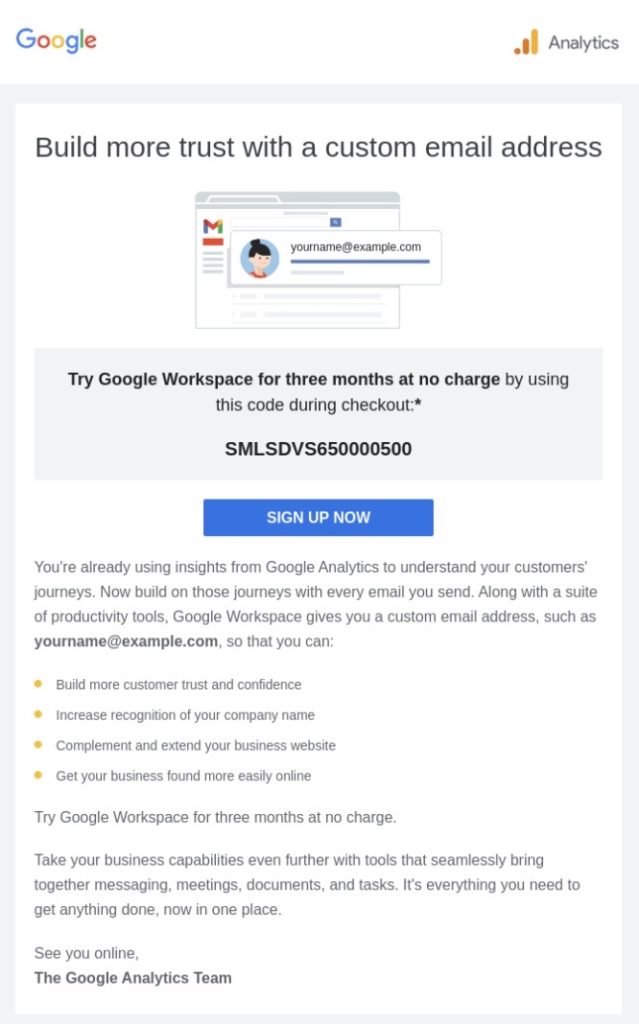
Google is well aware of the importance of having custom email addresses for businesses. For customers, getting a custom email address for free for three months is a good deal to miss. The email also mentions the importance of having a custom email address, thereby convincing the customers to grab their offer.
Email Subject Line
Your deal-focused subject lines need to scream value without looking like spam. Think of it as the difference between a clearance rack and a luxury sale—both are discounts, but one feels desperate while the other feels exclusive.
The key is being specific about the value while creating just enough urgency to make them act now instead of bookmarking for later.
Here are some subject lines that convert:
- “[Name], Here’s 40% Off (Just Because We Miss You)”;
- “Your Personal 48-Hour Flash Sale Starts Now”;
- “Free Shipping + 25% Off = Our Way of Saying Sorry”.
Email CTA
Here’s the thing about win-back deal email CTAs—they’re basically the “buy now” button’s cooler, more confident cousin. Place it right after you’ve laid out exactly what they’re getting and why it’s worth jumping on.
The best deal CTAs make people feel like they’re claiming something exclusive rather than just making another purchase. Think “Claim My Discount,” “Get My Deal,” or “Activate Offer”.
Performance Metrics & Results
Deal emails are where things get interesting from a measurement standpoint. You’re not just tracking opens and clicks—you’re trying to figure out if you’ve won someone back or just helped to create a discount freeloader who’ll disappear until your next win-back email.
The real, long-term challenge is separating customers who re-engage from those who are just bargain hunting.
Here’s what you need to keep tabs on:
- Discount redemption rates vs. repeat purchase behavior;
- Revenue per reactivated customer;
- Post-purchase engagement and retention rates.
Struggling to reconnect with inactive customers? Win them back with emails! Free email templates, drag-and-drop builder, automation—all in one tool.
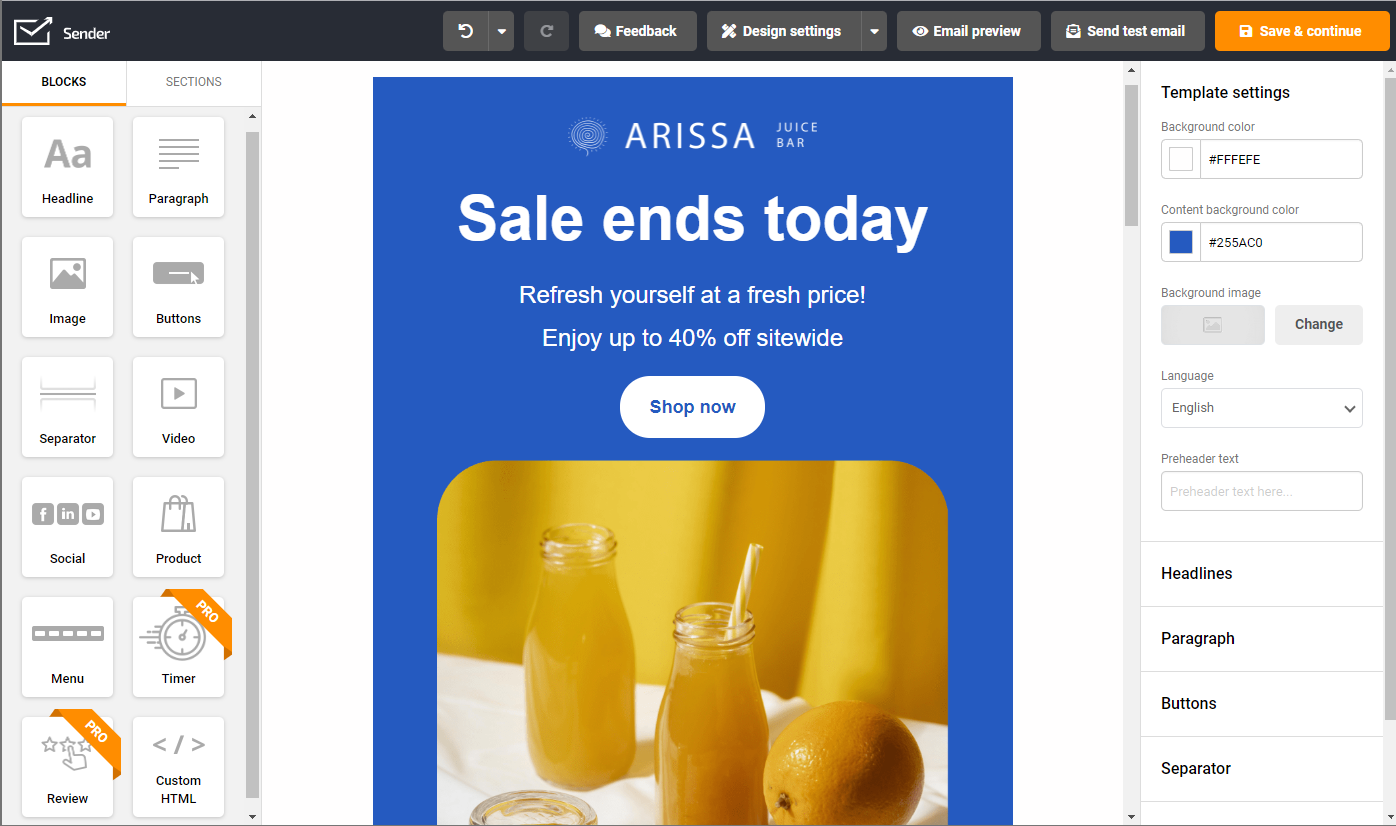
6. Recommend Various Products
Showcase your products or services to inactive customers and encourage them to buy from you with personalized product recommendations. Help your customers discover new things and create a sense of excitement that can inspire them to check out your products and make a purchase.
You will be surprised that sharing product recommendations in your email messages can increase your click-through rates by 840%.
Here is one of the best email examples to recover lost customers sent by Laura Mercier, a beauty products brand. Notice the product recommendations the brand shares with the customers based on their frequent purchases.
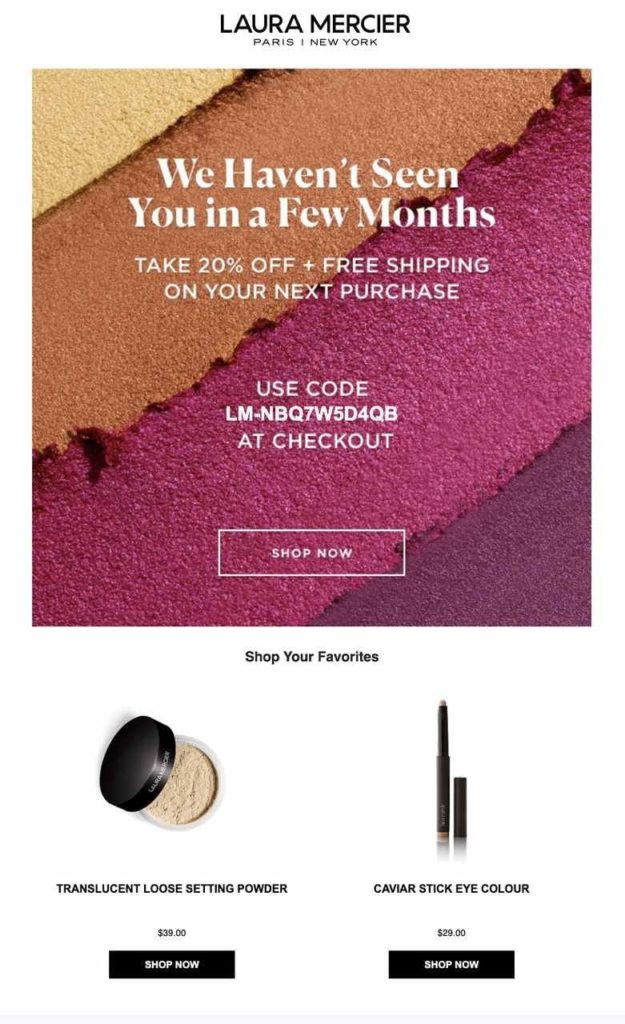
Laura Mercier keeps its email simple as inactive customers wouldn’t be willing to read a lot of copy. The email politely asks the customers to revisit their website and offers personalized product recommendations. Besides, email offers customers tangible incentives to impact the customer’s purchasing decisions.
Email Subject Lines
Product recommendation subject lines need to nail that perfect balance between “we know what you like” and “we’re not being weird about it.” The goal is making people curious about what you’ve picked out for them, not just sending a generic-looking spam with their name on it.
Go for a snappy subject line where they think “okay, I’ll bite” because your suggestion feels spot-on and not click-baity.
Here are a few subject lines that should get your started:
- “We Found 3 Things You’ll Actually Love, [Name]”;
- “Based on Your Last Order: You Might Want These”;
- “[Name], These Just Screamed Your Name”.
Email CTA
Product recommendation CTAs need to feel more like friendly suggestions than pushy sales pitches. Always a tricky line to balance, sure. That’s why it helps to anchor them in genuine insight—point out how the product fits into the user’s needs, goals, or even past behavior.
Try to position your call to action where the excitement builds, right after you’ve shown them why these specific products make sense for them. Go with something like, ‘Check Out Your Picks’ or ‘Don’t Miss Out on These Finds.’
Performance Metrics & Results
Measuring product recommendation emails comes down to knowing whether your suggestions are connecting with people or just missing the mark. It’s not enough to track CTR—you need to know if those recommendations drive real engagement.
Here are some metrics you should keep an eye on:
- Click-through rates on individual product recommendations;
- Conversion rates;
- Average order value from recommendations;
- Cross-category purchase behavior.
7. Educate about Pausing and Cancelation Options
If you’re a subscription-based business, educating customers about your pricing plans and how each of them works is the best win-back strategy to follow.
By informing customers about pausing and cancellation options, you give them knowledge and control over their subscription or membership. This empowers them to make informed decisions, and they may be more likely to continue their subscription or membership in the long run.
For instance, Netflix always assures regular and disengaged customers that they can cancel their subscriptions at any time if they choose to reactivate their accounts.
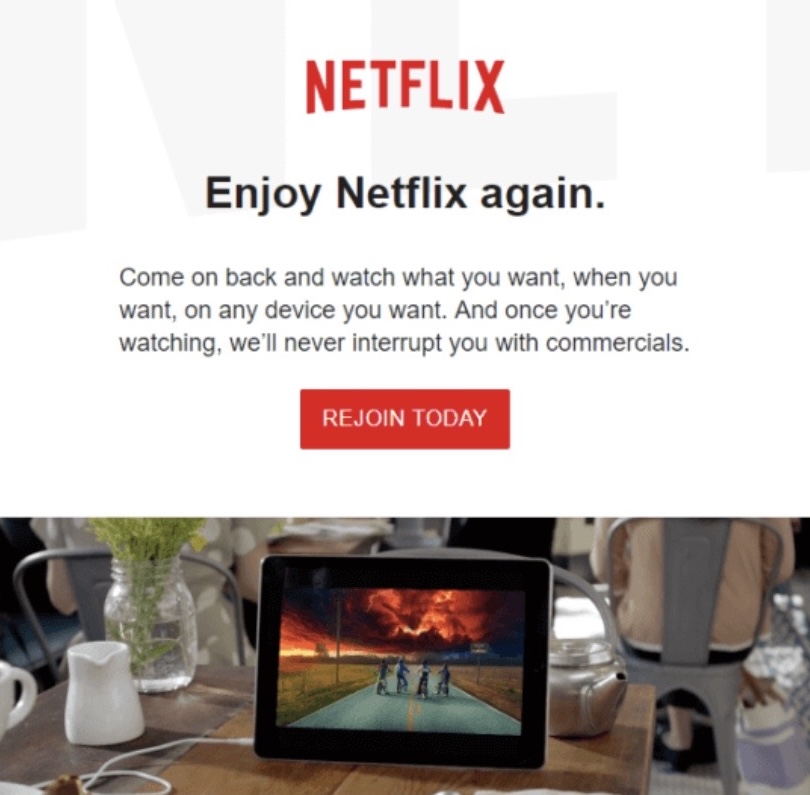
Email Subject Line
These subject lines need to walk a tightrope. You’re essentially saying, “Hey, we know you might want to leave, but here’s how to do it without actually leaving.” It’s counterintuitive marketing at its finest.
You want your subject line to sound helpful and transparent, not like you’re desperately trying to trap them.
Here are some subject lines that you can try out:
- “[Name], You Have Options (And We Want You to Know Them)”;
- “Pause, Don’t Cancel—Here’s Why It’s Better”;
- “Your Account, Your Choice: All Your Options Explained”.
Email CTA
Your CTA here is doing something pretty radical—it’s helping subscribers potentially leave you. But that’s the genius of it. When you make the “pause” option just as prominent as “stay subscribed,” you’re showing confidence in your value.
Position these options clearly and without guilt-tripping, because transparency builds more trust than desperation ever could.
Think phrasing that puts them in the driver’s seat—”Explore My Options,” “See All Choices,” or “Manage My Account”.
Performance Metrics & Results
Measuring these win-back emails feels backward because ‘success’ might actually mean people pausing their subscriptions.
But here’s the thing—you’re playing the long game. A customer who pauses and comes back is often more valuable than one who cancels outright. You’re essentially buying yourself time and goodwill.
Here are a few metrics that matter the most:
- Pause vs. cancel ratios after email engagement;
- Reactivation rates from paused accounts over time;
- Customer lifetime value of pausers vs. cancelers.
8. Mention the Offer in the Subject Line
Email subject lines play a crucial role in increasing open rates. In fact, 33% of customers admitted that they open emails because of these catchy subject lines.
Mentioning discounts in the subject lines is another excellent way to motivate customers to open your emails. It helps your messages stand out, compels your customers to view them, and delights them into making purchases.
Check out this email from Barista & Co, a UK-based coffee roaster offering its subscribers a treat. The minimal design gives this email message a clean look. Further, it piques the recipients’ curiosity by not revealing the offer right away.
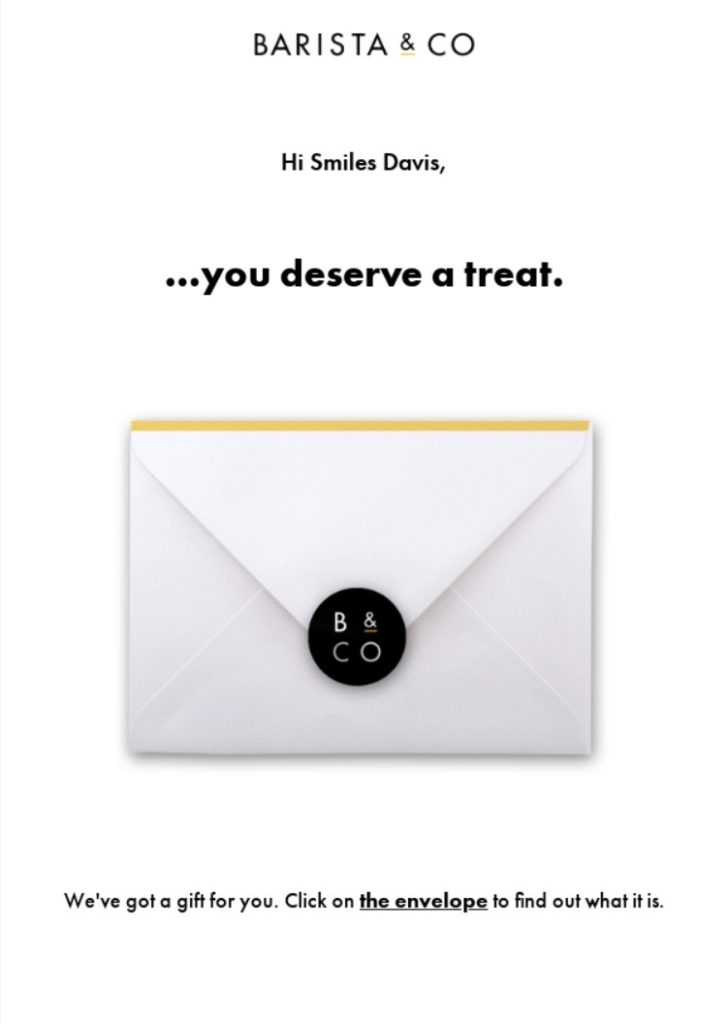
Barista & Co. uses an engaging phrase ‘free gift’ in the subject line that acts as a very compelling CTA and encourages customers to open the email. The email lacks fluff and delivers the intended message without beating around the bush.
Email Subject Lines
This type of win-back emails is where you stop playing coy and just put your cards on the table. Subject lines that mention the offer upfront are basically the email equivalent of cutting to the chase—no games, just “here’s what you get if you open this.”
Make your offer sound appealing enough that it doesn’t raise suspicion. You want it to land in that sweet spot where it feels like a deal they couldn’t walk away from.
Here are some subject lines that convert:
- “50% Off Everything—No Strings Attached, [Name]”;
- “Your Exclusive 24-Hour Sale: 30% Off + Free Shipping”;
- “[Name], Here’s $25 Off Your Next Order (Expires Tonight)”.
Email CTA
When your subject line already spilled the beans about your offer, your CTA needs to make claiming it feel effortless. Position your highly-visible call to action prominently, like right after the body text, and remove any friction that might make recipients second-guess clicking through.
Go with something direct like “Claim My 50% Off,” “Shop the Sale,” or “Use My Discount”. No need to be too clever about this.
Performance Metrics & Results
This type of win-back emails are pretty straightforward to measure because you’re basically running a mini flash sale. The challenge is figuring out whether your transparent approach builds more trust or if people just grab the deal and ghost you again.
The real challenge lies in comparing subject lines that highlight offers with those that take a more subtle approach. Being too direct about discounts can sometimes train recipients to overlook emails that don’t clearly scream “SALE!”
Here are the metrics you should monitor closely:
- Open rates vs. offer value;
- Conversion rates;
- Basket abandonment during offer period;
- Post-offer retention.
9. Re-engage Inactive Customers with a Seasonal Campaign
Leverage the timing and context of a particular season, event, or holiday to reconnect with past customers by talking about the season. Align such email campaigns with the need of the hour to offer seasonal customers compelling reasons to come back.
For example, Freshly, a meal delivery service, announced a $60 off a week before its Black Friday sale. In its email, Freshly explained how this discount would be divided over 4 orders, thus encouraging the customers to shop throughout the week to be eligible for the discount.
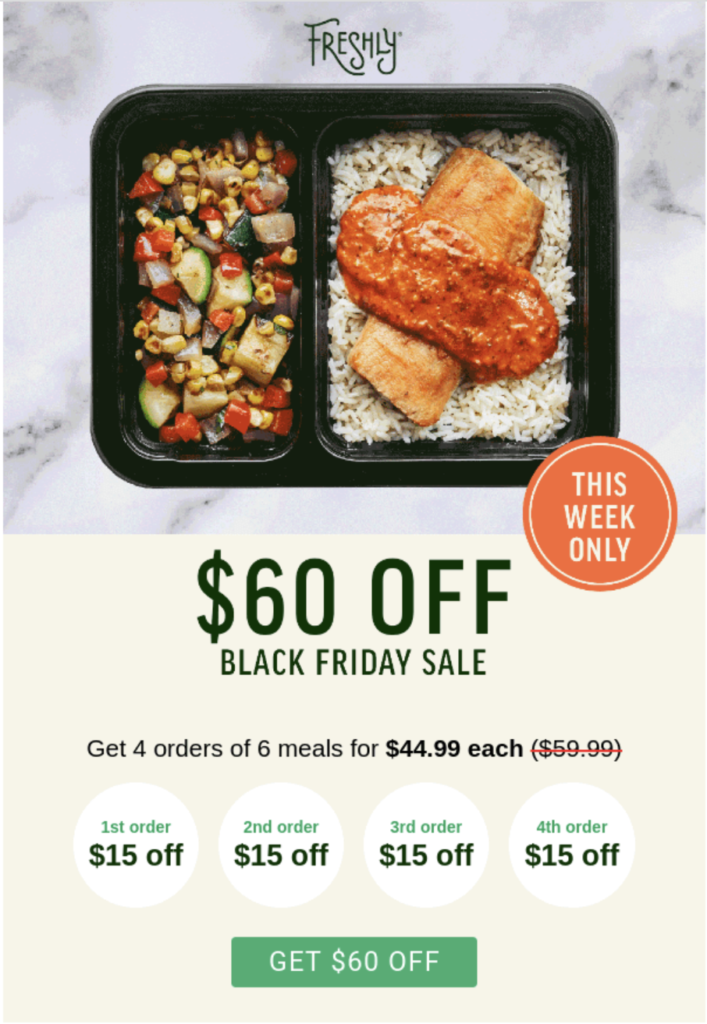
Freshly diverts its customer’s attention to its offering before the Black Friday sales actually begin. It keeps its customers engaged with this amazing offer, thereby remaining on top of its customer’s minds during the sale season.
This timing works well for Freshly’s short sales cycle, where customers can make quick decisions about meal delivery services. In our books, that’s one of the best winback campaign examples you can find.
Email Subject Lines
Seasonal campaigns are your chance to ride the wave of whatever everyone’s already thinking about. Whether it’s back-to-school madness, Halloween prep, or spring cleaning fever, it’s your chance to tap into that frenzy with a well-timed win-back email.
The beauty of seasonal subject lines is that you’re tapping into emotions and mindsets that are already there, not trying to create them from scratch. The key is to craft subject lines that naturally tie your brand to the occasion, without feeling pushy or overly salesy.
Here are some tried-and-tested subject lines you can experiment with:
- “[Name], Your Holiday Shopping Just Got Easier”;
- “Spring Forward with 25% Off Everything Fresh”;
- “Back-to-School = Back to You (Special Offer Inside)”.
Email CTA
Seasonal calls to action should feel like they’re helping subscribers tackle whatever the season throws at them, not just pushing another sale.
Instead of super generic “Shop Now”, you want CTAs that acknowledge what’s happening in people’s lives. For instance, during Christmas preparation, “Find the Perfect Gift” hits differently than “Buy Stuff.”
Think seasonal action words that match the mood. “Celebrate,” “Refresh,” or “Prepare” are a couple of time-tested expressions you can’t go wrong with.
Performance Metrics & Results
Seasonal campaigns require different measurement approaches since you’re competing against massive email volumes during peak periods.
Compare your seasonal performance to regular campaigns rather than raw numbers, and track whether seasonal engagers become long-term customers or disappear until next year’s sales.
Here’s what matters most:
- Seasonal open rates vs. regular campaign benchmarks;
- Revenue per seasonal reactivation vs. cost of seasonal competition;
- Post-season retention and engagement consistency.
10. Send Follow-Up Product Recommendations
Sending follow-up product recommendations to customers is yet another powerful way to personalize their shopping experience and increase the likelihood of a repeat purchase. Analyze your customers’ purchase history and browsing behavior to send targeted follow up email with product recommendations.
For example, Good Eggs sends emails containing new product recommendations to customers.
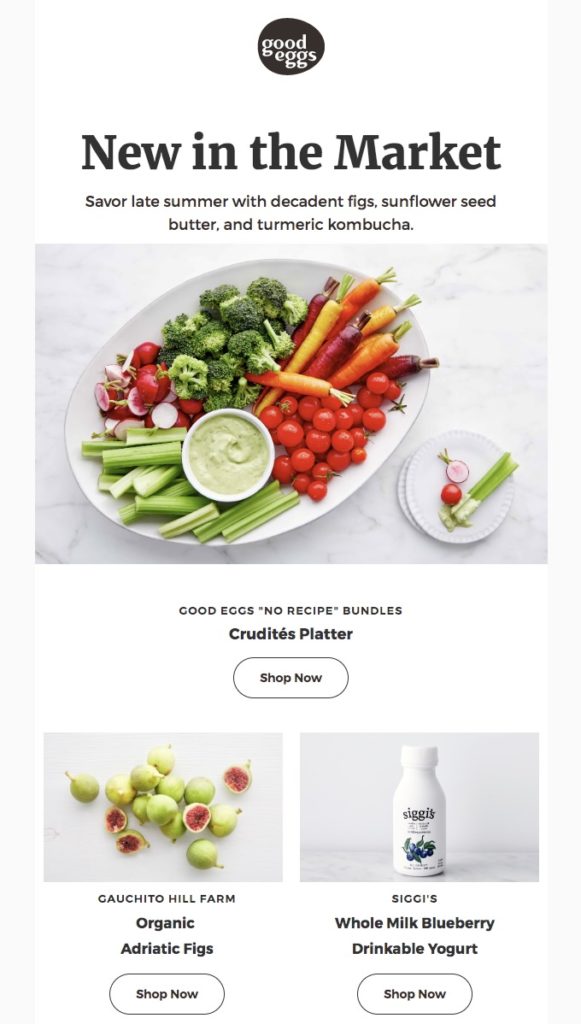
The email is personalized with recommendations based on their past browsing and purchase history. A clean and minimal layout keeps the focus on the products, tempting the user to purchase.
Email Subject Line
Follow-up recommendation subject lines are all about building on what already worked. You’ve got purchase history, browsing data, and proof that this person enjoyed your service – the foundation is already there.
The key with this type of win-back email is making it feel like a natural next step rather than aggressive upselling. You want that “Oh yeah, I could use that” moment, not “here we go… trying to squeeze more money out of me.”
Here are some subject lines that work:
- “Since You Loved [Product], You’ll Want to See This”;
- “[Name], We Restocked Your Favorites (Plus Something New)”;
- “Perfect Timing: Your Next Order Ideas Are Here”
Email CTAs
Your follow-up CTA should feel like a natural progression—an invitation to explore further, not a desperate attempt to sell. Place it where curiosity has been peaked, like after the main text, so it seamlessly links their previous purchase to your recommendation.
You want to leverage the fact that they’ve already proven they trust your products enough to buy once. Think “Browse Similar Items,” “See What’s New,” or “Add to Favorites”.
Performance Metrics & Results
Follow-up recommendations are where you can find out if you know your customers or if you’ve been making educated guesses this whole time.
The challenge is measuring not just clicks and conversions, but whether people actually feel like you “get” them.
Here are metrics you should focus on with follow-up recommendation emails:
- Cross-sell success rates;
- Recommendation relevance scores;
- Time between follow-up email and subsequent purchase.
11. Invite Customers to Visit Your Stores
Inviting customers to visit your stores offers you an excellent chance to revitalize their interests and foster a sense of personal connection. It allows you to highlight new products, limited edition collections, and more to generate curiosity among customers.
For example, Starbucks sent out an email informing its customers about the happy hour at their store. In other words, Starbucks invited its customers to visit their stores and grab exclusive deals on drinks, food items, and more.

This email is the best way to inform customers about the exclusive benefits and experiences Starbucks has in store for them.
Starbucks creates an opportunity for its customers to rediscover its brand, build stronger relationships, and enhance its brand-building process. This email itself can help the brand attract more new customers while encouraging existing customers to visit their stores during happy hours.
Email Subject Lines
Store invitation subject lines need to give people a compelling reason to leave their house and actually show up somewhere. In this day and age? Yeah, it’s easier said than done. You’re competing against the convenience of getting something while lying in your bed.
Whether it’s exclusive in-store events, hands-on experiences, or limited-time deals, like the Starbucks’ one, you need to make their trip worthwhile.
Here are some great subject lines that should do the trick:
- “[Name], Something Special Awaits You In-Store This Week”;
- “Exclusive Store Event: See It, Touch It, Take It Home Today”;
- “Your VIP Store Experience Starts This Weekend”.
Email CTAs
Your call to action needs to overcome the inertia of staying home and scrolling through your website instead. Make the action feel special and time-sensitive, not just another errand to add to their weekend list.
Include specific details like store hours, special events, or exclusive perks that make the trip feel purposeful rather than random. Think “Find My Store,” “Reserve My Spot,” or “Get Store Details”.
Performance Metrics & Results
Store invitation emails present a unique measurement challenge since you’re asking people to take their engagement offline. Unlike your standard email campaigns, where everything happens in trackable clicks and conversions, these emails succeed when people close their laptops. You need to track not just email engagement, but actual foot traffic and in-store behavior.
The real challenge is connecting email opens to store visits when most people won’t click through to get directions—they’ll just show up.
Here’s what matters most:
- Email engagement vs. actual store traffic increases;
- In-store conversion rates during campaign periods;
- Cross-channel customer journey from email to purchase.
12. Limited-Time Offer Email
One of the oldest selling tactics, creating urgency, still manages to encourage customers to make purchases. The feeling of FOMO plays a significant role in driving customers to make decisions instantly. Create a sense of urgency in your emails by setting deadlines, offering hard-to-get deals, or solving an unpleasant problem.
Here is an offer from Birchbox, a beauty subscription box. The brand announced a freebie item on all purchases above $29 for a limited duration. This urgency pushes their disengaged customers to take immediate action.
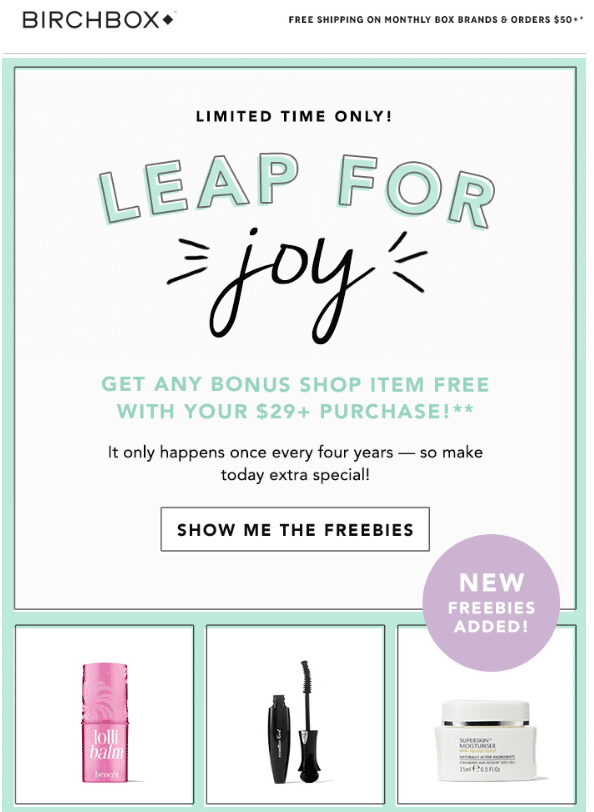
The freebie product incentive acts as a strong magnet for attracting customers. And this deal is available for a limited time, creating FOMO among customers leading to quicker purchases.
Email Subject Lines
Limited-time offers are all about creating that FOMO feeling where people feel like they might miss out on something genuinely good—even if they’ve forgotten about your brand for a while. In short, your subject line needs to create urgency without sounding desperate or pushy.
The magic happens when time pressure feels genuine rather than manufactured—nothing kills the fear of missing out faster than fake deadlines that get extended three times.
Here are some demo email subject lines for your win-back campaign:
- “Limited time: Grab XX% off now before it’s gone!”;
- “48 Hours Left: [Name], Your 40% Off Expires Sunday”;
- “[Name], 6 Hours to Save $50 (Then It’s Gone)”.
Email CTAs
Your limited-time calls to action should capture that moment when mental cogs start turning and they’re calculating whether they can afford NOT to buy something. Place the CTA just below the body message for that one-two punch combo.
The button text needs to reinforce the time pressure without being too pushy about it. Try “Claim Before Midnight,” “Get It Now,” or “Secure My Deal”.
Performance Metrics & Results
Limited-time offers are easy to measure in the short term—either people panic-bought or they didn’t. The real question is whether you’re building a sustainable business or just training subscribers to wait for your next fire sale.
To make sure that your limited-time offers are working as intended, keep an eye on these few metrics:
- Conversion velocity;
- Time-to-purchase patterns;
- Offer extension rates;
- Customer behavior on subsequent non-urgent campaigns.
13. Promote Free Shipping
Did you know that 49% of customers don’t complete their purchases because of additional costs, such as shipping fees, taxes, and more? Free shipping allows you to get back to these customers and encourage them to finish their checkout process.
Send out an email announcing free shipping to your customers, removing a potential barrier to their purchases. Craft your subject line to explicitly mention this offer.
Design Within Reach, a modern furnishings and lighting store, sent out an email announcing free shipping across their entire store for a certain time period. Besides free shipping, the store offered an additional discount of 15% on certain items. Free shipping and the discount offer is too good to miss.
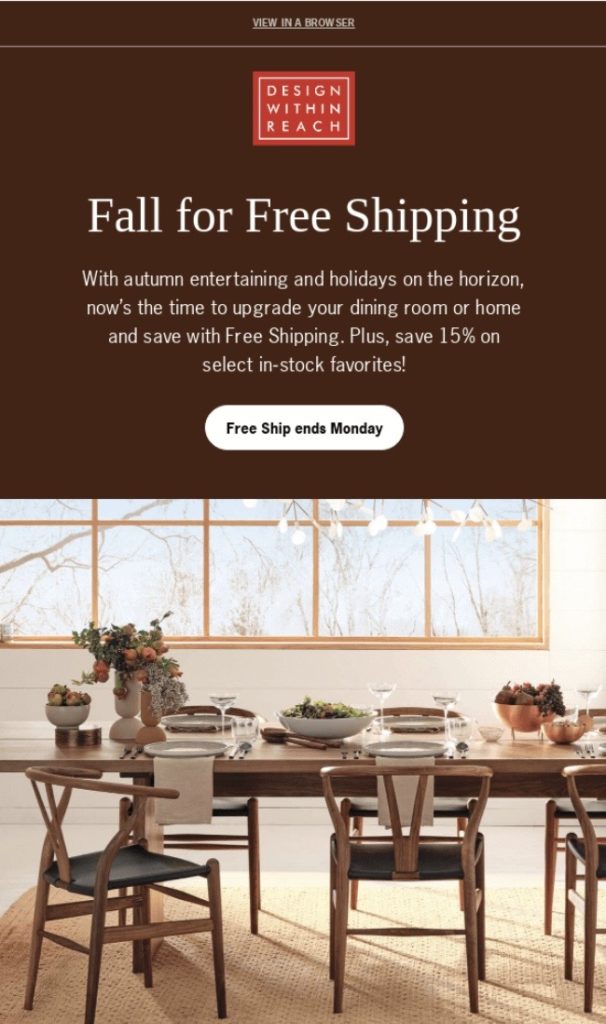
The email subtly mentions the availability of the deal and thus creates a ticking clock to encourage customers to place their orders. It gives customers an option to choose from a variety of their offerings.
Email Subject Lines
Free shipping subject lines are basically removing the most annoying part of online shopping—that moment when you’re ready to click ‘buy’ and surprise shipping costs stop you in your tracks. That’s why a good subject line needs to highlight this elimination of annoyance.
Make it feel like you’re solving a real problem. Here are some subject lines that work:
- “[Name], Free Shipping on Everything (Yes, Everything)”;
- “No Shipping Fees = More Money for the Good Stuff”;
- “Finally: Free Shipping That Actually Means Free”.
Email CTAs
Your free shipping CTA should emphasize the effortless experience you’re offering. People aren’t just buying your product—they’re buying convenience and predictability. Position the calls to action where the relief of “no hidden costs” sinks in.
Think “Shop with Free Shipping,” “Order Risk-Free,” or “Get It Delivered Free”—CTAs that explicitly call out the benefit rather than burying it in fine print.
Performance Metrics & Results
Free shipping promotions are tricky to measure in their own unique way because you’re essentially trading margin for conversion. The challenge is figuring out whether free shipping brings back inactive customers or just subsidizes purchases that would have happened anyway.
You need to track not just immediate sales, but whether people stick around after the promotion ends.
Here’s what matters most:
- Conversion lift vs. shipping cost absorption;
- Average order value changes during free shipping periods;
- Customer retention rates post-campaign.
14. Re-Engagement Survey Email
Re-engagement survey emails invite inactive subscribers to share their opinions in return for an incentive. The goal is to make the recipient feel valued and heard and in the process revive interest.
Here’s one of the coolest recovering old customers email examples by Graza that looks more like a message from a friend than a marketing team.
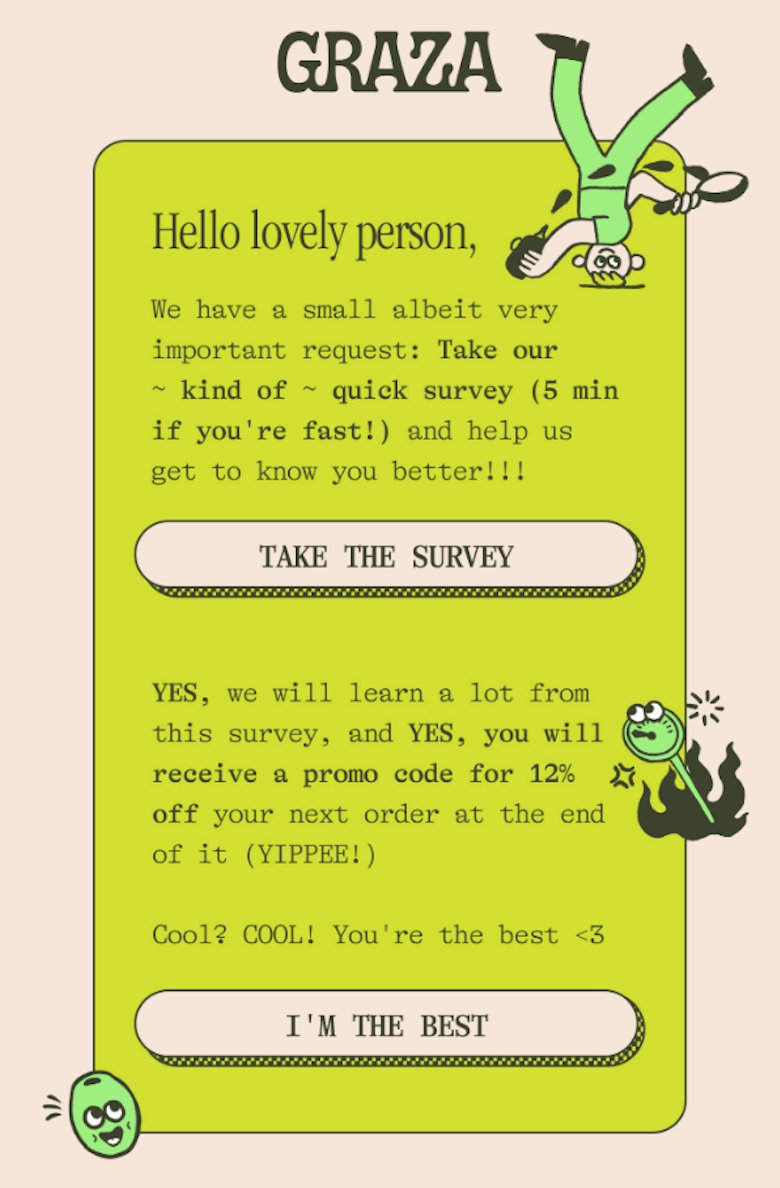
The greeting, ‘Hello lovely person’, instantly makes the reader feel appreciated, while the self-aware phrasing (“Take our ~ kind of ~ quick survey”) keeps things light.
Bright, friendly colors reinforce the brand’s quirky identity, making the experience feel fun rather than transactional. The CTA buttons, labeled “TAKE THE SURVEY” and “I’M THE BEST”, inject personality and are unmissable.
The promise of a discount code at the end of the survey gives recipients a tangible reason to participate.
Email Subject Lines
Survey subject lines face a fundamental challenge: you’re asking people to do work for you. Most people’s default response to survey requests is blissful ignorance or immediate deletion, which means your subject line needs to offer something valuable for their time.
Since most recipients decide to mark emails as spam based on the subject line, skip the corporate lingo. Unless your brand calls for it, avoid phrases like ‘valuable feedback’.
Get straight to the point with a clear incentive or spark real curiosity about why they’ve gone silent. Anyway, here are some subject lines that should get you going:
- “[Name], Quick Question: What Did We Mess Up?”;
- “2-Minute Survey = $10 Gift Card (Fair Trade?)”;
- “Help Us Fix This + Get Something Nice in Return”.
Email CTAs
Survey calls to action should respect the fact that you’re asking for someone’s most valuable asset: their free time. Be upfront about how long it’ll take and what they’ll get in return.
Use straightforward, action-oriented phrasing like “Take a 2-Minute Survey” or “Share My Thoughts”. This way you’re clearly communicating the value of participating.
Performance Metrics & Results
Survey emails operate on completely different success metrics than your typical marketing campaigns. You’re not just chasing opens and clicks—you’re hunting for genuine insights that can improve your business. Use insights from feedback to craft subsequent messages that address the specific concerns customers raise.
The real challenge is balancing response quantity with response quality. Sometimes a shorter survey with fewer but better answers beats a comprehensive one nobody finishes.
Here’s what you should look out for:
- Survey completion rates vs. abandonment points;
- Response quality and actionable insight generation;
- Cost per meaningful feedback vs. business impact.
Win-Back Strategies That Work for Every Business
There’s no real one-size-fits-all strategy to win back lapsed customers. For instance, using the same win-back email approach for a subscription box brand might completely fall flat for a SaaS company.
In the following part, we’ll break down how to shape your win-back campaign around your business.
Ecommerce Tips to Win Customers Back
Every brand loses customers now and then—that comes with the territory. The good news is that getting them back is where you can make a mark.
Your customer win-back campaign should start by figuring out why your customers lapsed. Maybe it’s been a while since their last order? Use all the information that you can gather to send them a quick “We miss you” note or a limited-time discount to win them back.
Also, look at the examples of successful customer win-back emails for some inspiration.
Smart Moves for SaaS and Subscriptions
The hard truth is that churn is part of the game in SaaS and subscription-based services—as of 2025, the average churn rate for B2B SaaS companies sits around 3.5%. But there’s nothing that can’t be fixed with the right, systematic approach.
Start by analyzing your data: are users dropping off after a free trial, or canceling after a certain feature update? A quick follow-up email from support asking if they need any assistance or a special offer to resubscribe can go a long way.
How Retail & Service Brands Can Reconnect
Customers don’t disappear without a good reason. That’s why understanding why they walked away in the first place is the key to winning them back.
Use this data to craft a personalized win-back email that shows you genuinely care. Whether it’s a reminder of your best products (think similar to what they’ve bought before) or a cheeky thank-you note.
Successful win-back email content for bringing back old customers makes it clear you’d love to see them back. At the end of the day, you have to respect if customers decide to move on.
Track Win-Back Campaign Success
Re-engaging inactive customers takes more than just catchy subject lines, and figuring out if it’s working is as much an art as writing the emails themselves.
Effective win-back email content for bringing back old customers can be gamechanging—especially when you know how to track its success. Here are some pro tips you can use to see if your campaigns are performing:
Top Metrics to Know
Every content marketing manager worth their salt should know which metrics to track if they want to get the most out of their email win-back campaigns. So, without further ado, let’s break down the key numbers that show whether your best win-back email strategies are paying off.
- Open Rates. This benchmark shows how convincing your subject lines and timing are. If people aren’t opening your emails, it’s time to head back to the drawing board.
- Reactivation Rates. This metric measures how many inactive users start engaging again. It’s the clearest sign your email win-back campaign is working.
- Conversion Rates. Following the uptick of these rates shows how many reactivated users complete a desired action (like a purchase), helping you gauge return on investment (ROI) directly.
- Clickthrough Rates. CTR reveals how compelling your email content and CTAs are—if people are clicking, you’re doing it right.
Setting Realistic Benchmarks
Setting your hopes too high is never a good thing. While it’s good to stay optimistic about re-engaging lapsed customers, understanding industry benchmarks for each metric will help you see whether your win-back campaign is performing well or needs some tweaking.
- Open Rates’ benchmark. Open rates for win-back email campaigns can vary significantly. Some studies report averages around 12%, while others, particularly for automated win-back emails, report averages as high as 42%.
- Reactivation Rates’ benchmark. Reactivation rates can vary widely depending on the industry and win-back campaign you’re going for. Customers who used to purchase frequently typically have higher reactivation rates than one-time buyers, with some studies showing up to 40% higher success rates.
- Conversion Rates’ benchmark. Conversion rates for win-back emails also vary. Some sources report average conversion rates around 0.89%, while others note that automated win-back emails can achieve lip-smackingly surprising conversion rates of 10%.
- Clickthrough Rates’ benchmark. CTRs for win-back emails can be significantly higher than general email campaigns. Automated win-back emails have reported CTRs of 18%.
Measure Your ROI
Measuring your ROI is essential to understanding whether your win-back email campaigns are paying off. By having a grip on these few metrics, you can assess if your ROI is satisfactory:
- Cost per Reactivated Customer. Figure out how much you’re spending to bring each customer back by dividing your total campaign costs by the number of customers who re-engage;
- Lifetime Value (LTV) Increase: Look at how much more reactivated customers are spending or engaging after the campaign compared to before. It shows if bringing them back leads to long-term value;
- Revenue Generated. Track the total income that comes from customers who returned because of the campaign. This gives you a clear picture of how much money your win-back email campaigns are bringing in.
Boost Results with A/B Testing
Don’t just use the same old customer re-engagement email samples over and over again. Testing and optimizing your email win-back campaign is key to making it as effective as possible. If you’re trying to re-engage inactive customers, you need to be willing to experiment and adjust along the way.
This is where the beauty of A/B testing comes into play. By testing two or more versions of the following elements in your win-back emails, you can see what works best and what falls flat:
- Subject Lines. A/B testing different subject lines helps you find the tone, length, or style that grabs the most attention.
- Calls to Action (CTAs). Testing different wording, placement, or design of your CTAs can reveal what motivates lapsed customers to engage.
- Visuals. A/B testing visuals lets you see which designs keep readers interested and enhance your message more effectively. Sometimes, a small tweak in illustration can boost clicks or conversions significantly.
Key Elements of a High-Converting Win-Back Email
A win back email sequence isn’t just about saying “We miss you”. It’s about knowing what to say, how to say it, and when to send it to give customers a compelling reason to re-engage.
Here are the key elements that make ecommerce win-back emails successful:
- Personalization. Address customers by name, but don’t stop there. Use personalized recommendations, exclusive discounts, or tailored messaging to show them you understand their needs;
- Timing. Analyze customer behavior to find the best moment to send a customer win back email—whether it’s 30, 60, or 90 days of inactivity. For example, sending a reminder just before a subscription renewal or a seasonal sale;
- Attention-grabbing subject lines. Your subject line is your first (and sometimes only) chance to make an impact. Keep it short, engaging, and curiosity-driven. For example, ‘Is this goodbye? Here’s a special offer if you stay’;
- Relevance. Segment customers based on purchase history, customer engagement level, or preferences to send highly relevant win-back messages. For example, an inactive customer who bought sneakers before should get a different message than someone who browsed but never purchased;
- Clear and actionable CTA. Don’t leave them guessing. Your CTA should tell them exactly what to do next, using a visually appealing button and concise copy. For example, “Come Back & Save 20%”;
- Ask for feedback. Some customers stop engaging because of frustrations or unmet needs. Ask them for feedback and show them you’re listening—include social proof like customer testimonials and reviews;
- Follow up elsewhere. If email alone isn’t working, extend your re-engagement efforts to SMS and social media through retargeting ads. Remember, customers are everywhere—your outreach should be, too.

